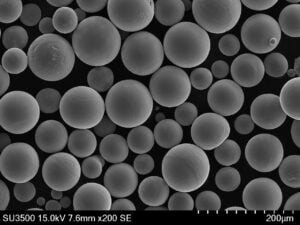3D Printed Turbocharger Ducts
Innehållsförteckning
Introduction – The Critical Role of 3D Printed Turbocharger Ducts in Modern Automotive Engineering
In the relentless pursuit of enhanced performance, fuel efficiency, and reduced emissions, the automotive industry continually explores innovative manufacturing techniques. Among these, metal additive manufacturing, commonly known as metal 3D printing, has emerged as a transformative force, offering unprecedented design freedom and material versatility. One critical application where metal 3D printing is making significant strides is the production of automotive turbocharger ducts. These intricate components play a vital role in the engine’s air intake system, directly impacting the turbocharger’s efficiency and overall engine performance. Traditional manufacturing methods often impose limitations on the complexity and optimization of these ducts, hindering the ability to achieve ideal airflow and pressure characteristics. However, with the advent of advanced metal 3D-utskrifter technologies and high-performance metal powders, such as IN718 and IN625, engineers and procurement managers now have access to solutions that can unlock new levels of design innovation and performance optimization for turbocharger systems. This blog post delves into the myriad benefits of utilizing metal 3D printing for manufacturing automotive turbocharger ducts, exploring material selection, design considerations, and the advantages this technology offers over conventional methods.
What are 3D Printed Turbocharger Ducts Used For? Enhancing Performance and Efficiency
Automotive turbocharger ducts are integral components within the engine’s forced induction system. Their primary function is to efficiently channel compressed air from the turbocharger’s compressor to the engine’s intake manifold. The design and material properties of these ducts directly influence the flow rate, pressure, and temperature of the air entering the combustion chamber, thereby significantly affecting the engine’s power output, torque, and fuel economy.
Here’s a breakdown of the key roles of 3D printed turbocharger ducts:
- Optimized Airflow Dynamics: The layer-by-layer manufacturing process of metal 3D printing allows for the creation of complex internal geometries and smooth, optimized flow paths that are often impossible to achieve with traditional manufacturing techniques. This results in reduced turbulence and pressure drop, leading to more efficient delivery of compressed air to the engine.
- Viktminskning: Metal 3D printing enables the creation of lightweight yet structurally robust ducts through design optimization and material selection. Using materials like IN718 and IN625, which offer high strength-to-weight ratios, can significantly reduce the overall weight of the turbocharger system and the vehicle, contributing to improved fuel efficiency and handling.
- Enhanced Thermal Management: Turbocharger ducts are subjected to high temperatures. Materials like IN718 and IN625 exhibit excellent high-temperature strength and corrosion resistance, ensuring the durability and reliability of the duct in demanding operating conditions. Furthermore, design freedom allows for the integration of cooling features directly into the duct structure.
- Customization and Rapid Prototyping: Metal 3D printing facilitates the rapid prototyping and customization of turbocharger duct designs. Engineers can quickly iterate through different geometries and optimize the duct for specific engine configurations and performance requirements, significantly reducing development time and costs.
- Integration of Features: Additive manufacturing allows for the integration of multiple functionalities into a single component. For example, mounting features, sensor housings, or even cooling channels can be directly incorporated into the 3D printed turbocharger duct, reducing the number of parts and simplifying assembly.
By leveraging the capabilities of metal 3D printing, automotive manufacturers can produce turbocharger ducts that are not only lighter and more efficient but also tailored to specific engine needs, ultimately leading to enhanced vehicle performance and reduced environmental impact.
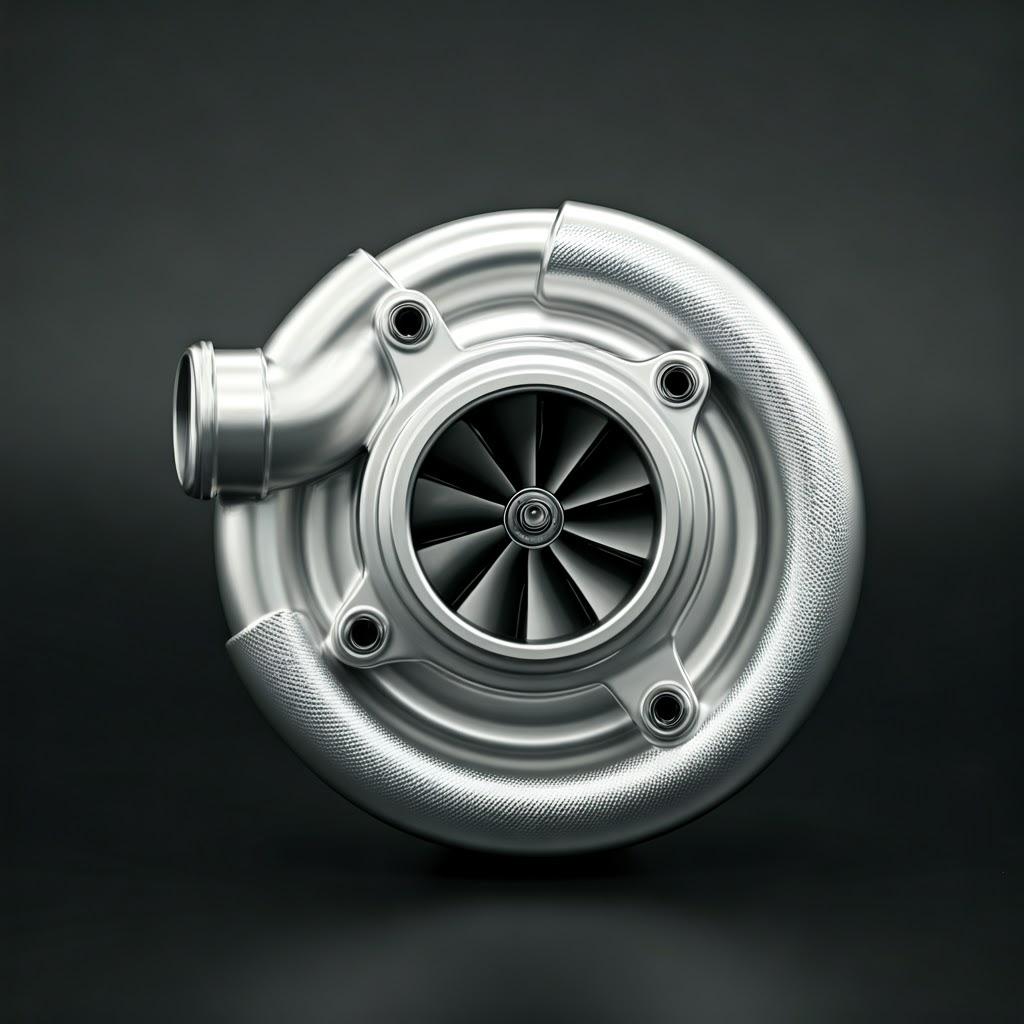
The Compelling Advantages of Metal 3D Printing for Turbocharger Duct Manufacturing
Compared to traditional manufacturing methods like casting, forging, or machining, metal 3D printing offers a unique set of advantages for the production of automotive turbocharger ducts:
- Design Freedom and Complexity: Metal 3D printing unleashes unparalleled design freedom. Intricate internal channels, complex curves, and optimized flow paths can be created without the tooling constraints of traditional methods. This allows engineers to design ducts that maximize airflow efficiency and minimize pressure loss, leading to improved turbocharger performance.
- Materialeffektivitet: Additive manufacturing processes build parts layer by layer, using only the material needed for the component. This significantly reduces material waste compared to subtractive methods like machining, where a substantial portion of the raw material is removed. For high-value alloys like IN718 and IN625, this material efficiency translates to significant cost savings.
- Rapid Prototyping and Reduced Lead Times: Metal 3D printing drastically reduces the lead time for producing prototypes and final parts. Complex tooling is not required, allowing for faster design iterations and quicker time-to-market for new vehicle models or performance upgrades. Companies like Metall3DP offer rapid prototyping services that can significantly accelerate the development cycle.
- Kundanpassning och tillverkning på begäran: Metal 3D printing enables the production of customized turbocharger ducts tailored to specific engine requirements or low-volume production runs without the need for expensive tooling changes. This agility is particularly beneficial for niche vehicle markets or aftermarket performance parts.
- Lättviktspotential: Through topology optimization and the creation of complex lattice structures, metal 3D printing allows for the design of turbocharger ducts with significantly reduced weight while maintaining or even enhancing structural integrity. This contributes to improved fuel efficiency and vehicle dynamics.
- Integration of Functionality: As mentioned earlier, additive manufacturing allows for the integration of multiple features into a single part, reducing the number of components, simplifying assembly, and potentially improving reliability. This can include integrated mounting points, sensor housings, or cooling channels.
- Förbättrad prestanda: The ability to optimize the internal geometry of the ducts for smoother airflow and reduced turbulence directly translates to improved turbocharger efficiency and engine performance. This can lead to increased power output, better torque delivery, and enhanced fuel economy.
By embracing metal 3D printing, automotive manufacturers can overcome the limitations of traditional methods and unlock new possibilities for designing and producing high-performance, efficient, and lightweight turbocharger ducts.
Selecting the Right Materials: Why IN718 and IN625 are Ideal for Turbocharger Ducts
The selection of the appropriate metal powder is crucial for achieving the desired performance and durability of 3D printed automotive turbocharger ducts. Two nickel-based superalloys, Inconel 718 (IN718) and Inconel 625 (IN625), stand out as particularly well-suited for this application due to their exceptional properties:
Inconel 718 (IN718):
- High Strength at Elevated Temperatures: IN718 exhibits outstanding tensile, creep, and rupture strength at high temperatures, making it ideal for the demanding thermal environment within a turbocharger system.
- Excellent Corrosion and Oxidation Resistance: This alloy offers superior resistance to corrosion and oxidation, ensuring the long-term reliability of the duct when exposed to hot exhaust gases and other corrosive elements.
- Good Weldability and Fabricability: While traditionally challenging to machine, IN718 demonstrates good weldability and is well-suited for powder bed fusion-based 3D printing processes offered by companies like Metall3DP.
- High Fatigue Strength: Turbocharger ducts are subjected to cyclic loading. IN718’s high fatigue strength ensures the component can withstand these stresses over extended periods.
Inconel 625 (IN625):
- Exceptionellt motståndskraftig mot korrosion: IN625 offers even greater corrosion resistance than IN718, particularly in harsh environments with a wide range of corrosive agents.
- Hög hållfasthet och seghet: This alloy maintains high strength and toughness across a broad temperature range, providing excellent structural integrity for the turbocharger duct.
- Good Fabricability: IN625 is also well-suited for metal 3D printing, allowing for the creation of complex geometries with high precision.
- Resistance to Oxidation and Carburization: IN625 exhibits excellent resistance to oxidation and carburization at high temperatures, further enhancing its suitability for turbocharger applications.
The choice between IN718 and IN625 often depends on the specific performance requirements and operating environment of the turbocharger system. IN718 is typically preferred for applications where high strength at elevated temperatures is paramount, while IN625 is favored for its superior corrosion resistance in particularly aggressive environments. Metall3DP offers a range of high-quality metal powders, including IN718 and IN625, specifically optimized for additive manufacturing.
The table below summarizes the key properties of IN718 and IN625 relevant to turbocharger duct applications:
| Fastighet | IN718 | IN625 | Relevance to Turbocharger Ducts |
|---|---|---|---|
| Tensile Strength (High Temp) | Utmärkt | Hög | Withstanding high operating temperatures and pressures |
| Motståndskraft mot korrosion | Mycket bra | Exceptionell | Preventing degradation from exhaust gases and environmental factors |
| Oxideringsbeständighet | Mycket bra | Utmärkt | Maintaining integrity in high-temperature, oxygen-rich environments |
| Utmattningshållfasthet | Hög | Hög | Ensuring durability under cyclic loading conditions |
| Fabricability (3D Printing) | Bra | Bra | Enabling the creation of complex duct geometries |
| Vikt | Hög densitet | Hög densitet | Impacting overall vehicle weight and fuel efficiency |
| Kostnad | Generally Lower than IN625 | Generally Higher than IN718 | Influencing the overall cost of the manufactured component |
Export to Sheets
By carefully considering the material properties and the specific demands of the application, engineers can leverage the benefits of IN718 or IN625 through metal 3D printing to produce high-performance and durable automotive turbocharger ducts.
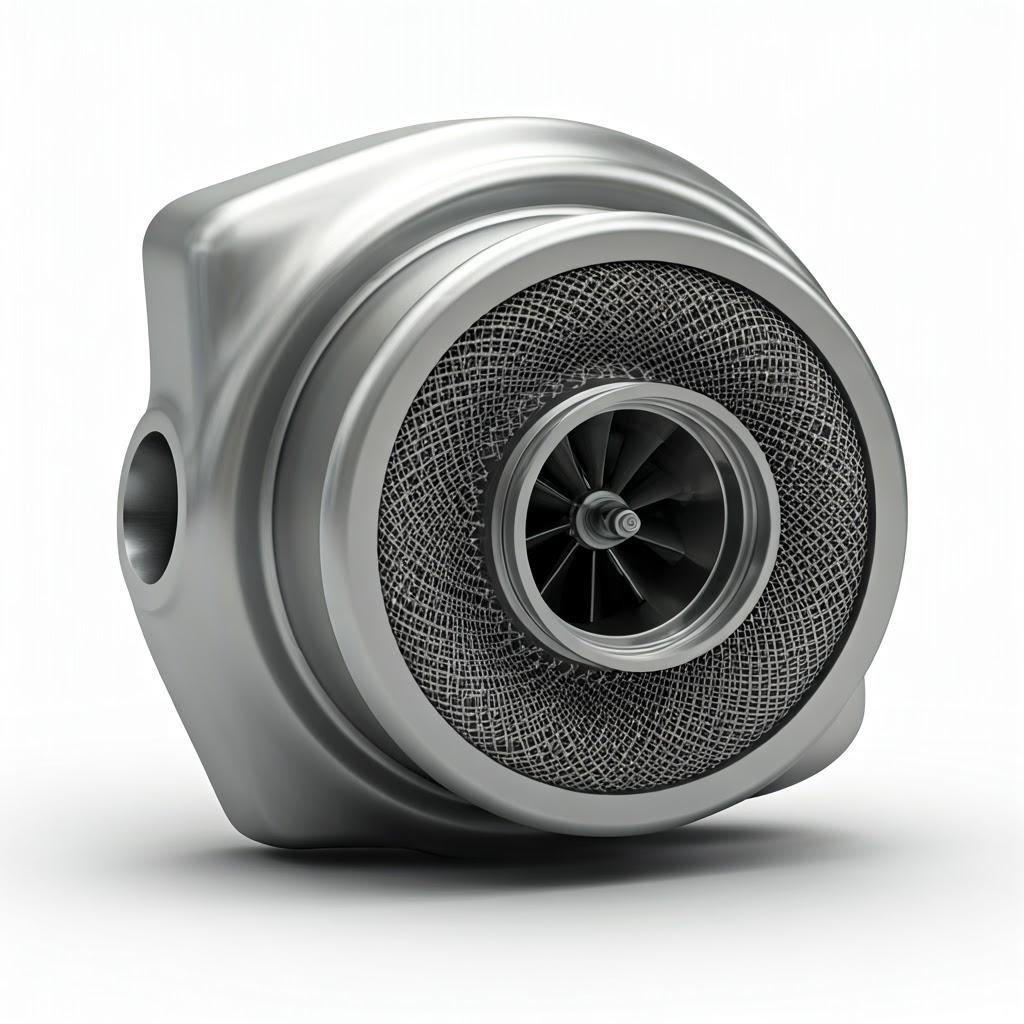
Design Optimization for Additive Manufacturing of Turbocharger Duct Geometries
The transition from traditional manufacturing to metal 3D printing opens up a realm of possibilities for optimizing the design of automotive turbocharger ducts. Unlike subtractive or formative processes with inherent tooling limitations, additive manufacturing allows for the creation of complex internal and external geometries that can significantly enhance performance and efficiency.
Here are key design considerations for optimizing turbocharger ducts for metal 3D printing:
- Flow Path Optimization: One of the most significant advantages of 3D printing is the ability to design internal channels with smooth, organic curves that minimize turbulence and pressure drop. Computational Fluid Dynamics (CFD) analysis can be iteratively employed to refine these internal geometries for optimal airflow. Features like gradual bends, optimized inlet and outlet shapes, and strategically placed flow dividers can be incorporated to improve the efficiency of the compressed air delivery.
- Lightweighting through Topology Optimization and Lattice Structures: Metal 3D printing enables the creation of lightweight yet structurally sound components. Topology optimization algorithms can be used to identify areas of the design where material can be removed without compromising structural integrity. Furthermore, intricate lattice structures can be incorporated into non-critical areas to reduce weight while maintaining stiffness and strength. This is particularly beneficial for reducing the overall mass of the turbocharger system and improving vehicle performance.
- Integration of Features: Design for additive manufacturing (DfAM) principles encourage the integration of multiple functionalities into a single component. For turbocharger ducts, this could include:
- Integrated Mounting Features: Eliminating the need for separate brackets and fasteners by directly incorporating mounting points into the duct design.
- Sensor Housings: Creating dedicated spaces for temperature or pressure sensors, streamlining assembly and improving the accuracy of measurements.
- Cooling Channels: Integrating internal cooling channels to manage the high temperatures of the compressed air, potentially improving the density and performance of the intake charge.
- Wall Thickness and Support Structures: Careful consideration must be given to wall thickness to balance weight reduction with structural integrity. The minimum wall thickness achievable depends on the chosen metal powder and the capabilities of the 3D printing equipment, such as those offered by Metall3DP. Support structures are often necessary to prevent deformation during the printing process, especially for overhanging features and internal channels. The design should aim to minimize the need for extensive support structures to reduce material waste and post-processing effort.
- Surface Finish Considerations: The as-printed surface finish of metal 3D printed parts can vary depending on the printing parameters and the metal powder used. For turbocharger ducts, a smooth internal surface is desirable to minimize friction and maximize airflow. Design considerations might include orienting the part during printing to minimize the step effect on critical internal surfaces or planning for post-processing steps like polishing or abrasive flow machining.
By embracing these design considerations specific to additive manufacturing, engineers can create turbocharger ducts that outperform conventionally manufactured components in terms of efficiency, weight, and functionality.
Achieving Precision: Tolerance, Surface Finish, and Dimensional Accuracy in 3D Printed Ducts
In the demanding environment of automotive engineering, particularly for critical components like turbocharger ducts, achieving tight tolerances, a suitable surface finish, and high dimensional accuracy is paramount. Metal 3D printing technologies have advanced significantly in their ability to meet these requirements.
- Dimensional Accuracy and Tolerance: The dimensional accuracy achievable with metal 3D printing depends on several factors, including the printing technology (e.g., Selective Laser Melting (SLM), Direct Metal Laser Sintering (DMLS)), the material used, the part geometry, and the calibration of the 3D printer. High-precision metal 3D printers, such as those developed by Metall3DP, can achieve tolerances in the range of ±0.1 mm or even finer in certain applications. Careful design, proper build orientation, and optimized printing parameters are crucial for maximizing dimensional accuracy.
- Ytfinish: The as-printed surface finish in metal 3D printing typically has a certain degree of roughness due to the layer-by-layer build process and the partially melted powder particles on the surface. The surface roughness (Ra) can range from 5 to 20 µm depending on the process and material. For internal flow passages in turbocharger ducts, a smoother surface finish is often desired to minimize friction and improve airflow. Post-processing techniques like abrasive flow machining, polishing, or electrochemical polishing can be employed to achieve smoother surfaces.
- Factors Affecting Precision: Several factors can influence the tolerance, surface finish, and dimensional accuracy of 3D printed metal parts:
- Pulver Egenskaper: The particle size distribution, sphericity, and flowability of the metal powder significantly impact the final part quality. Metall3DP emphasizes the use of high-quality metal spherical powders for optimal printing results.
- Printing Parameters: Laser power, scan speed, layer thickness, and build orientation are critical parameters that must be carefully controlled to achieve the desired precision.
- Printer Calibration and Maintenance: Regularly calibrated and well-maintained 3D printing equipment is essential for consistent and accurate results.
- Stödstrukturer: The placement and removal of support structures can sometimes affect the surface finish of certain areas of the part.
- Thermal Management During Printing: Controlling the temperature of the build platform and the part during the printing process is crucial to minimize warping and ensure dimensional accuracy.
- Quality Control and Inspection: To ensure that 3D printed turbocharger ducts meet the required specifications, rigorous quality control and inspection procedures are necessary. This can include dimensional measurements using coordinate measuring machines (CMMs), surface roughness testing, and non-destructive testing methods like X-ray computed tomography (CT) to identify internal defects.
By carefully considering these factors and leveraging the capabilities of advanced metal 3D printing technologies and post-processing techniques, it is possible to achieve the precision required for high-performance automotive turbocharger ducts.
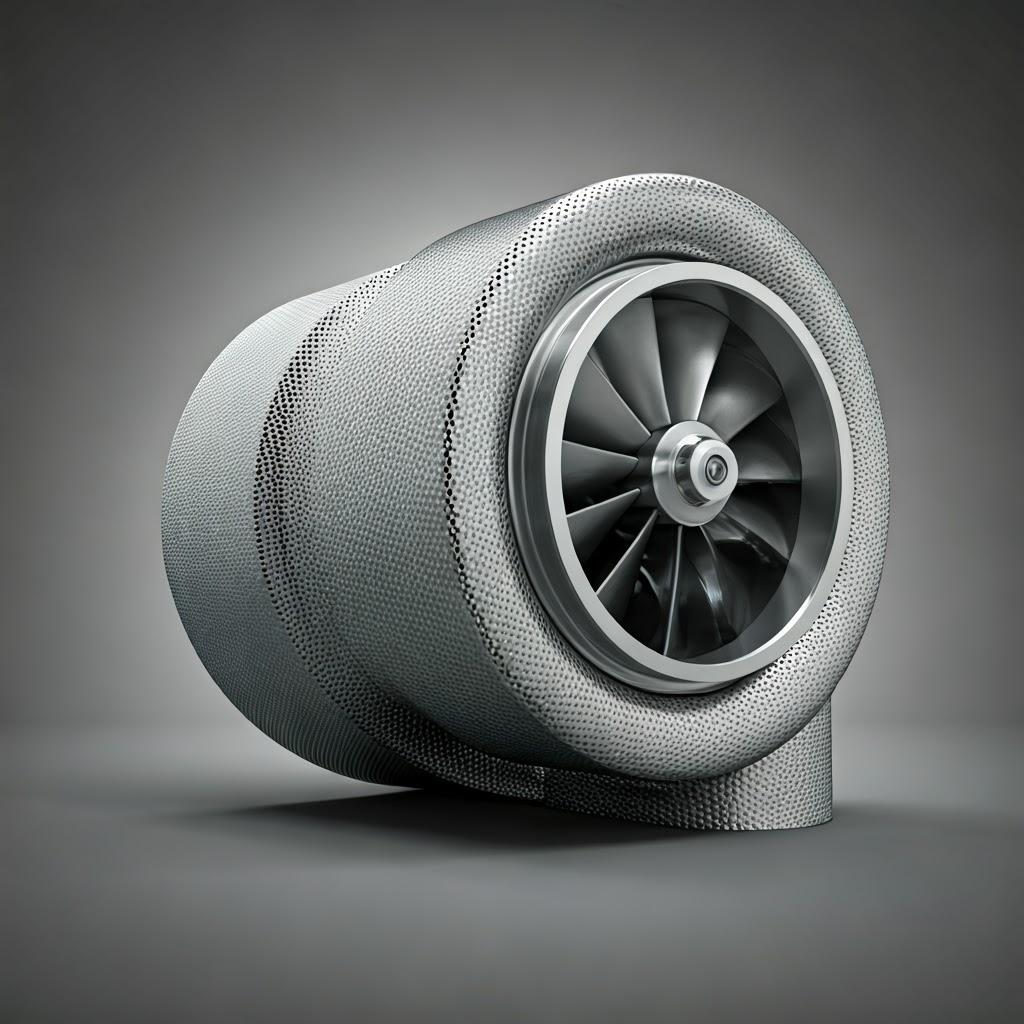
Streamlining Production: Post-Processing Techniques for 3D Printed Turbocharger Ducts
While metal 3D printing offers significant advantages in terms of design freedom and complexity, post-processing steps are often required to achieve the final desired properties, surface finish, and dimensional accuracy of automotive turbocharger ducts. The specific post-processing requirements depend on the application, the material used, and the desired end-use characteristics.
Common post-processing techniques for 3D printed metal parts, including turbocharger ducts, include:
- Powder Removal: After the printing process, loose or semi-sintered powder needs to be carefully removed from the build chamber and any internal channels or cavities within the part. This is typically done using brushes, compressed air, or vacuum systems. For intricate internal geometries, specialized powder removal techniques might be necessary.
- Borttagning av stödstruktur: Support structures, which are often required to prevent deformation during printing, need to be removed. This can be done manually using hand tools, or with automated methods like wire electrical discharge machining (EDM) for more complex or difficult-to-access supports. The removal process needs to be carefully controlled to avoid damaging the part’s surface.
- Stress Relief Heat Treatment: Metal 3D printed parts often contain residual stresses due to the rapid heating and cooling cycles during the printing process. Stress relief heat treatment is performed to reduce these internal stresses, improving the part’s dimensional stability and mechanical properties. The specific temperature and duration of the heat treatment depend on the material.
- Het isostatisk pressning (HIP): HIP is a process where the 3D printed part is subjected to high pressure and temperature simultaneously. This process helps to densify the material, reduce porosity, and improve its mechanical properties, particularly fatigue strength. HIP is often used for critical aerospace and automotive components.
- Ytbehandling: As mentioned earlier, the as-printed surface finish may not be suitable for all applications. Various surface finishing techniques can be employed to achieve smoother surfaces, including:
- Machining (CNC): Precision machining can be used to achieve tight tolerances and smooth surface finishes on critical mating surfaces or external features.
- Polering: Mechanical or chemical polishing can be used to reduce surface roughness, improve aesthetics, and potentially enhance corrosion resistance.
- Abrasive Flow Machining (AFM): This technique involves forcing an abrasive-laden fluid through internal channels to smooth their surfaces, which is particularly beneficial for optimizing airflow in turbocharger ducts.
- Electrochemical Polishing: This method uses an electrochemical process to selectively remove material from the surface, resulting in a smoother finish.
- Beläggning: Depending on the application requirements, coatings may be applied to enhance corrosion resistance, wear resistance, or thermal barrier properties. Common coatings include ceramic coatings, PVD coatings, or electroplating.
- Inspection and Quality Control: After post-processing, thorough inspection is crucial to ensure that the parts meet the required dimensional accuracy, surface finish, and material properties. Techniques like CMM measurements, surface roughness testing, and non-destructive testing are employed.
By carefully selecting and implementing the appropriate post-processing techniques, manufacturers can transform as-printed metal parts into high-performance, ready-to-use automotive turbocharger ducts that meet stringent industry standards. Metall3DP can provide guidance on the optimal post-processing workflows for different materials and applications.
Overcoming Challenges in Metal 3D Printing of Automotive Components
While metal 3D printing offers numerous advantages, there are also challenges that need to be addressed to ensure the successful production of high-quality automotive components like turbocharger ducts. Understanding these challenges and implementing appropriate mitigation strategies is crucial for wider adoption of this technology in the automotive industry.
Common challenges in metal 3D printing include:
- Warping and Distortion: Thermal gradients during the printing process can lead to residual stresses, causing warping or distortion of the part, especially for complex geometries or large parts. Optimized build orientation, support structure design, and controlled cooling rates are essential to minimize these issues. Simulation tools can also help predict and mitigate potential distortion.
- Support Structure Design and Removal: Designing effective support structures that adequately support the part during printing while being easy to remove without damaging the surface can be challenging. Optimizing support geometry and attachment points is crucial.
- Porosity and Defects: Internal porosity or other defects can occur due to insufficient melting or sintering of the metal powder. Optimizing printing parameters, using high-quality powders with good flowability (as provided by Metall3DP), and employing post-processing techniques like HIP can help minimize porosity and improve the density of the parts.
- Ytfinish: Achieving a smooth surface finish directly from the printing process can be difficult. As discussed earlier, post-processing steps are often required to meet the surface finish requirements for critical applications.
- Material Property Variability: The mechanical properties of 3D printed metal parts can sometimes exhibit anisotropy (direction-dependent properties) due to the layer-by-layer build process. Optimizing printing parameters and build orientation can help to minimize this variability. Heat treatment processes can also improve the homogeneity of material properties.
- Scalability and Cost: While metal 3D printing is ideal for prototyping and low-to-medium volume production, scaling up production for high volumes can present challenges in terms of build time and cost-effectiveness compared to traditional high-volume manufacturing methods. However, advancements in printing speed and automation are continuously improving the scalability of metal 3D printing.
- Powder Management and Safety: Handling metal powders requires specific safety precautions to prevent inhalation and ensure a clean working environment. Proper powder storage, handling procedures, and ventilation systems are essential.
- Standardization and Qualification: The lack of comprehensive industry standards and qualification processes for 3D printed metal automotive components can be a barrier to widespread adoption in safety-critical applications. Ongoing research and development efforts are focused on establishing these standards.
Addressing these challenges requires a combination of optimized design practices, careful selection of materials and printing parameters, appropriate post-processing techniques, and adherence to strict quality control measures. Collaborating with experienced metal 3D printing service providers like Metall3DP can help automotive manufacturers navigate these challenges and successfully implement metal additive manufacturing for their applications.
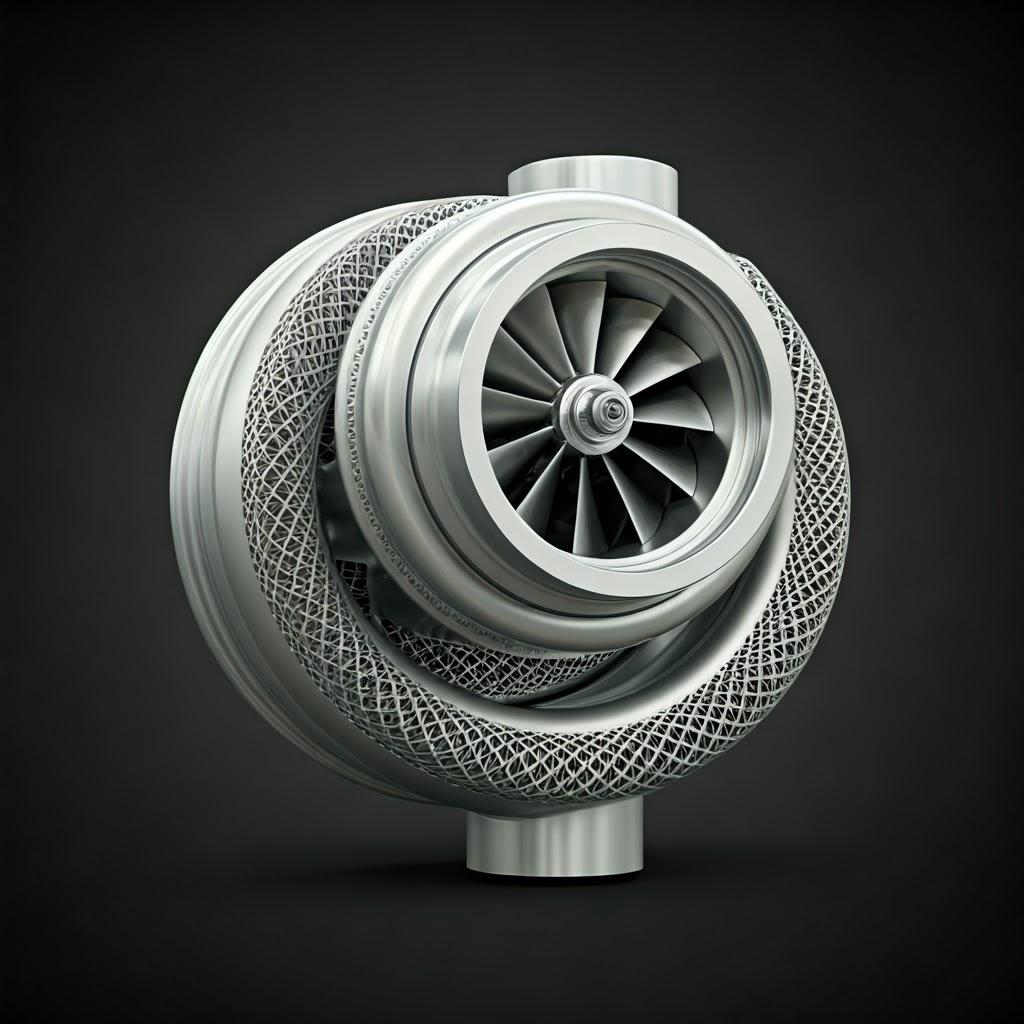
Partnering for Success: Choosing a Reliable Metal 3D Printing Service Provider
Selecting the right metal 3D printing service provider is a critical decision that can significantly impact the success of your project, especially when it comes to manufacturing high-performance automotive components like turbocharger ducts. A reliable partner will possess the expertise, equipment, and quality control processes necessary to deliver parts that meet your specific requirements.
Here are key factors to consider when choosing a metal 3D printing service provider:
- Material Capabilities: Ensure the provider has experience working with the specific metal powders required for your application, such as IN718 and IN625. They should have a proven track record of processing these materials and understand their unique characteristics and processing parameters. Metall3DP offers a wide range of high-performance metal powders and demonstrates expertise in their application.
- Technology and Equipment: Inquire about the types of metal 3D printing technologies they utilize (e.g., SLM, DMLS, EBM). The choice of technology can influence the achievable part complexity, accuracy, and surface finish. Ensure they have well-maintained and calibrated equipment to guarantee consistent results.
- Design and Engineering Support: A valuable service provider will offer design for additive manufacturing (DfAM) expertise to help optimize your turbocharger duct design for the 3D printing process. This can include guidance on topology optimization, lightweighting strategies, and feature integration.
- Post-Processing Capabilities: Understand the in-house post-processing services offered, such as powder removal, support removal, heat treatment, surface finishing, and coating. A provider with comprehensive post-processing capabilities can streamline the production process and ensure the final parts meet your specifications.
- Quality Assurance and Inspection: Robust quality control procedures are essential. Inquire about their inspection processes, including dimensional measurements, surface finish analysis, and non-destructive testing methods. Certifications such as ISO 9001 or AS9100D can indicate a commitment to quality management.
- Experience and Industry Knowledge: Look for a provider with a strong track record and experience in serving the automotive industry or similar demanding sectors like aerospace or medical. Their understanding of industry-specific requirements and standards is crucial.
- Communication and Customer Support: Effective communication and responsive customer support are vital for a smooth and successful partnership. They should be able to provide clear and timely updates on your project and address any concerns promptly.
- Lead Times and Production Capacity: Discuss their typical lead times for similar projects and their production capacity to ensure they can meet your volume requirements and delivery schedules.
- Cost Structure and Transparency: Understand their pricing model and ensure transparency in their cost breakdown. Request a detailed quote that outlines all costs involved, including printing, materials, and post-processing.
By carefully evaluating these factors, you can select a metal 3D printing service provider that aligns with your project goals and can deliver high-quality automotive turbocharger ducts that meet your performance and reliability expectations.
Cost-Effective Solutions: Understanding the Economics of 3D Printed Turbocharger Ducts
The cost-effectiveness of using metal 3D printing for manufacturing automotive turbocharger ducts is a multifaceted consideration that goes beyond just the per-part printing price. While initial costs might sometimes be higher than traditional methods for very high volumes, metal 3D printing can offer significant economic advantages in various scenarios.
Factors influencing the cost of 3D printed turbocharger ducts include:
- Kostnader för material: The cost of the metal powder (e.g., IN718, IN625) is a significant factor. High-performance alloys can be expensive, but the material efficiency of additive manufacturing, where only the necessary material is used, can help offset this cost compared to subtractive methods. Metall3DP focuses on providing high-quality powders to optimize material usage and part performance.
- Printing Time and Volume: The build time for a turbocharger duct depends on its complexity, size, and the chosen printing technology. Longer build times translate to higher machine operating costs. However, advancements in printing speed and larger build volumes are continuously improving the cost-effectiveness for larger production runs.
- Kostnader för efterbearbetning: The extent of post-processing required (e.g., support removal, heat treatment, surface finishing, machining) significantly impacts the overall cost. Designing parts to minimize the need for extensive post-processing is crucial for cost optimization.
- Tooling Costs: Unlike traditional manufacturing methods that require expensive tooling (molds, dies), metal 3D printing typically involves minimal or no tooling costs. This makes it highly cost-effective for low-to-medium volume production, custom designs, and rapid prototyping.
- Design Complexity and Optimization: Metal 3D printing allows for the creation of complex geometries without significant cost increases, unlike traditional methods where complexity often drives up tooling and manufacturing costs. The ability to optimize designs for performance and weight reduction can lead to long-term cost savings through improved fuel efficiency and reduced material usage in the overall vehicle.
- Lead Times and Time-to-Market: The ability to rapidly prototype and produce functional parts with metal 3D printing significantly reduces lead times compared to traditional manufacturing, which can involve lengthy tooling development. This faster time-to-market can translate to significant economic advantages, especially in the fast-paced automotive industry.
- Supply Chain Efficiency: Metal 3D printing can enable on-demand manufacturing and reduce the need for large inventories, leading to lower warehousing and logistics costs.
When is Metal 3D Printing Cost-Effective for Turbocharger Ducts?
- Low-to-Medium Volume Production: For production runs that don’t justify the high upfront costs of traditional tooling.
- Komplexa geometrier: When the design requires intricate internal features or optimized shapes that are difficult or impossible to achieve with conventional methods.
- Rapid Prototyping and Design Iteration: To quickly test and refine designs without incurring significant tooling costs.
- Customization and Lightweighting: When tailored designs or significant weight reductions offer performance or efficiency advantages that outweigh the per-part printing cost.
- Replacement Parts and Low-Volume Aftermarket: For producing obsolete or low-demand replacement parts without the need for maintaining expensive tooling.
By carefully analyzing the production volume, design complexity, material requirements, and the overall value proposition, automotive manufacturers can determine when metal 3D printing offers a cost-effective solution for producing high-performance turbocharger ducts.
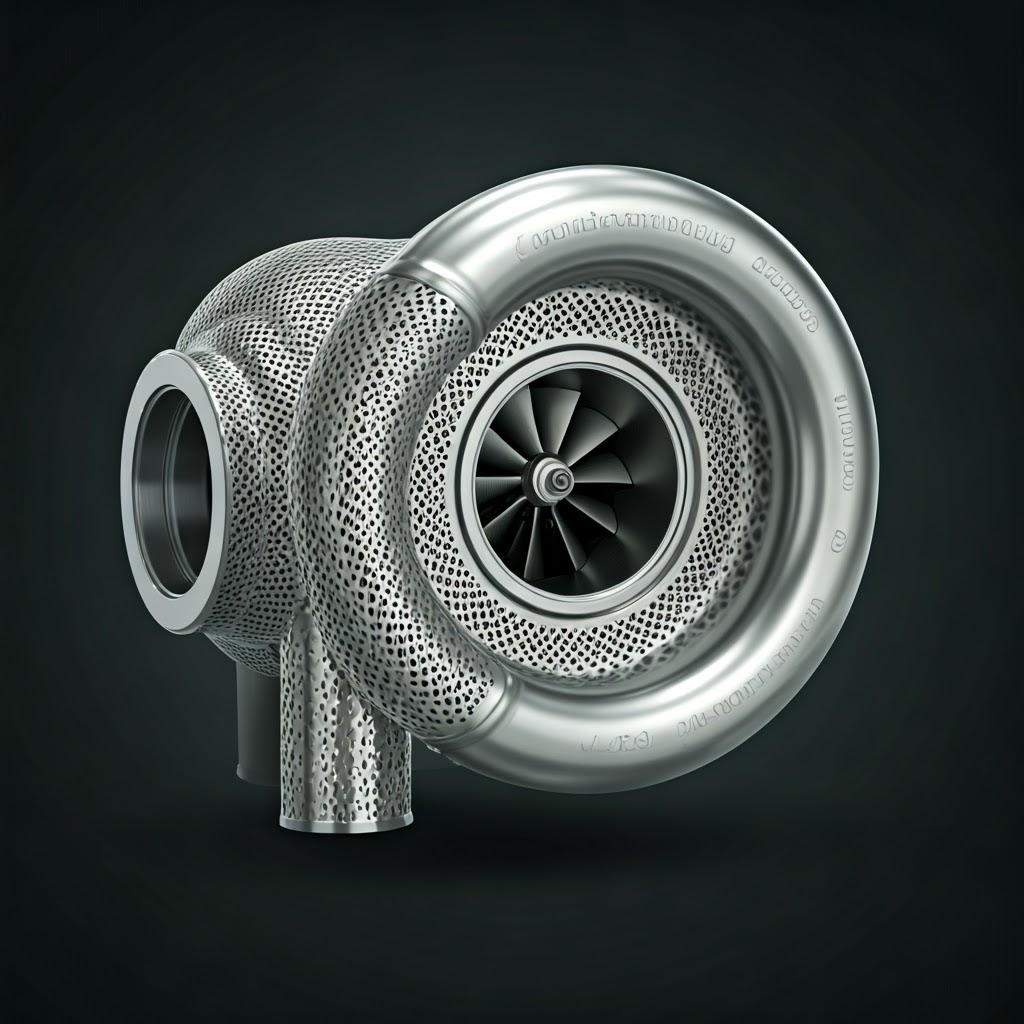
Vanliga frågor och svar (FAQ)
- What is the typical lead time for 3D printed metal turbocharger ducts? Lead times can vary depending on the complexity of the part, the chosen material, the printing technology used, and the post-processing requirements. For prototypes, lead times can be as short as a few days to a couple of weeks. For production volumes, it can range from several weeks to a few months, depending on the quantity and the service provider’s capacity. Collaborating with a provider like Metall3DP with efficient processes can help minimize lead times.
- Are 3D printed metal turbocharger ducts as durable as traditionally manufactured ones? Yes, when the appropriate materials (like IN718 or IN625) and optimized printing parameters are used, 3D printed metal turbocharger ducts can achieve comparable or even superior durability to traditionally manufactured parts. Post-processing techniques like HIP can further enhance their mechanical properties and fatigue resistance.
- Can metal 3D printing be used for mass production of automotive parts? While metal 3D printing is currently more prevalent in prototyping and low-to-medium volume production, advancements in printing speed, automation, and build volume are continuously improving its scalability for higher volumes. For very high volume production, traditional methods may still be more cost-effective, but metal 3D printing is becoming increasingly viable for larger batch sizes.
Conclusion: Driving Innovation with Metal 3D Printed Turbocharger Ducts
Metal 3D printing is revolutionizing the design and manufacturing of automotive components, and turbocharger ducts are a prime example of its transformative potential. By offering unparalleled design freedom, material efficiency, rapid prototyping capabilities, and the ability to optimize performance through complex geometries and lightweighting, metal additive manufacturing empowers engineers and procurement managers to push the boundaries of automotive innovation.
The use of high-performance alloys like IN718 and IN625, processed with advanced 3D printing technologies offered by companies like Metall3DP, enables the creation of turbocharger ducts with enhanced efficiency, durability, and performance characteristics. While challenges exist, ongoing advancements in materials, processes, and post-processing techniques are continuously expanding the possibilities and cost-effectiveness of metal 3D printing for automotive applications.
As the automotive industry continues its relentless pursuit of greater efficiency, performance, and sustainability, metal 3D printing will undoubtedly play an increasingly critical role in the development and production of innovative components like turbocharger ducts, driving us towards a future of advanced and high-performing vehicles. Contact Metall3DP today to explore how their comprehensive metal additive manufacturing solutions can power your organization’s automotive innovation journey.
Dela på
MET3DP Technology Co, LTD är en ledande leverantör av lösningar för additiv tillverkning med huvudkontor i Qingdao, Kina. Vårt företag är specialiserat på 3D-utskriftsutrustning och högpresterande metallpulver för industriella tillämpningar.
Förfrågan för att få bästa pris och anpassad lösning för ditt företag!
Relaterade artiklar

Högpresterande segment för munstycksvingar: Revolutionerande turbineffektivitet med 3D-utskrift i metall
Läs mer "Om Met3DP
Senaste uppdateringen
Vår produkt
KONTAKTA OSS
Har du några frågor? Skicka oss meddelande nu! Vi kommer att betjäna din begäran med ett helt team efter att ha fått ditt meddelande.

Metallpulver för 3D-printing och additiv tillverkning
FÖRETAG
PRODUKT
cONTACT INFO
- Qingdao City, Shandong, Kina
- [email protected]
- [email protected]
- +86 19116340731








